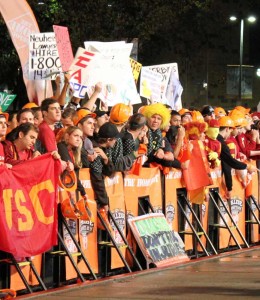USC hopes ‘GameDay effect’ can pay off
On Saturday, as No. 20 USC hosts No. 4 Stanford, a team that arguably boasts college football’s most recognizable player in Heisman Trophy candidate quarterback Andrew Luck, ESPN’s College GameDay will once again descend on South Los Angeles, broadcasting from the peristyle end of the Los Angeles Memorial Coliseum starting at 6 a.m.
Strong showing · When ESPN’s College GameDay arrived at USC for its matchup with Oregon game last season, the Coliseum drew 88,726 fans. - Photo courtesy of Shotgun Spratling
The last time the show stopped in Los Angeles — for last year’s game against then-No. 1 Oregon — 88,726 people turned out to the Coliseum. In 2008, when ESPN came to see the Trojans play Ohio State, the Coliseum was sold out, drawing 93,607 fans. In fact, GameDay has visited USC on seven separate occasions from 2004 to 2010, and USC has averaged 91,536 fans per contest during those seven games.
“It really helps bring a lot more awareness to the game,” USC Associate Athletic Director of Marketing Jose Eskenazi said. “There’s so much promotion that ESPN puts behind it that it just draws a lot more attention.”
But so far this season, attendance has been well below those GameDay numbers, averaging just 67,918 fans, which puts USC on track for its lowest home attendance since the 2002 season when it averaged 66,852 fans per contest.
Needless to say, players and coaches are hoping the “GameDay effect” and a strong opponent in the Cardinal will draw a significantly larger crowd to the Coliseum come Saturday. As of Wednesday, just 1,000 tickets remain for the game, according to school officials.
“I think it’ll be exciting,” USC coach Lane Kiffin said. “I think the Coliseum will be the best it’s been in years, especially with a great rivalry with Stanford.”
Kiffin wasn’t alone in his optimism. Following Tuesday’s mid-morning practice, junior quarterback Matt Barkley expressed similar sentiments.
“It should be lot of fun with Gameday, and it’s parents weekend,” Barkley said. “Hopefully a lot more people show up.”
The last time the Trojans played at home, an Oct. 1 game against Arizona, the official attendance number was 63,707, the lowest figure since the Trojans hosted Washington on Oct. 19, 2002.
From 2003 to 2008, when USC, led by Pete Carroll, compiled an overall 71-7 record, including two Associated Press national championships and six BCS bowl appearances, an average of 86,599 fans flooded the Coliseum gates on gameday — best among all Pac-10 venues.
But attendance has steadily declined since the Trojans’ Rose Bowl season in 2008.
“Since Carroll left, there doesn’t seem to be as much of a crowd,” said Ray Gutierrez, who has been attending football games at the L.A. Coliseum since the 1986 season. “It comes with the win-loss record … Is that due to the sanctions and diminished expectations? Probably.”
In 2009, Carroll’s final season with the program, USC, which finished the year with a 9-4 overall record and an appearance in the Emerald Bowl, averaged 84,799 fans per game — roughly 3,000 less than the previous season.
And in 2010, the first year of a two-year postseason ban as part of NCAA-levied sanctions, the drop continued, as USC averaged 79,907 fans per contest. The Trojans won eight games that season — their lowest total since 2001.
“Winning, especially here in L.A., seems to drive [attendance] a lot,” Eskenazi said. “We have our core group of alumni, fans and students, but to hit that critical mass — where we’re at 90,000 sometimes — requires more than just our standard posters and schedule cards.”
Though attendance was on the decline, USC’s season average still ranked the highest among all Pac-10 schools. Washington averaged 66,264 fans at its Husky Stadium in 2010 — the second highest in the conference — and UCLA averaged 60,376 per game at the Rose Bowl, third highest.
USC does have an advantage to some degree. The Coliseum’s seating capacity stands at 93,000, which makes it the largest stadium in the conference. Oregon, which was ranked No. 1 overall for much of the 2010 season, sold out all six of its home games, but capacity at Autzen Stadium is only 54,000.
With 10 losses since 2009, USC’s attendance decline is to be expected somewhat according to Jeff Fellenzer, a USC sports, business and media professor.
“It’s a combination of things,” Fellenzer said. “I think it’s a natural reaction to being in the transition from a magical time with Pete Carroll to the realities of a new unproven coach and NCAA sanctions.”
Tickets, however, aren’t cheap, and it has become easier in recent years to keep up with the team without going to the games.
“Every significant college football game on any Saturday is on television,” Fellenzer said. “With the quality of home entertainment systems now and the fact that replay has become a more important issue, there is more incentive to just watch the games on TV unless you have a product that is at a very high level.”
Fans, it seems, expect that Saturday’s product, as the Trojans host what Kiffin describes as arguably the nation’s best team, might be at that level — at least based on ticket sales so far.
“It’s going to be a great atmosphere,” junior left tackle Matt Kalil said. “It’s definitely going to motivate us to get that win.”
Though USC hasn’t reached 90,000 at the Coliseum since 2009, it looks like that might change against Stanford.
“Those are ’SC fans,” Kalil said with a grin. “They want to come to all the big games.”
Sean McCormick contributed to this report.

